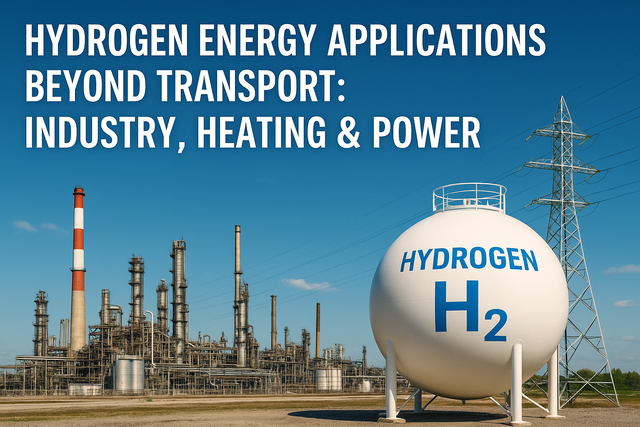
Hydrogen Energy Applications Beyond Transport: Industry, Heating & Power
As the global energy transition gathers pace, hydrogen energy is emerging as a transformative force, extending far beyond its early applications in transport. This versatile energy carrier is now driving innovation across industries, heating systems, and power generation. Its ability to store, transport, and release energy without emitting carbon makes it an essential element in the global decarbonization journey.
Table of Content
Hydrogen Energy in Industrial Applications
Industries worldwide face mounting pressure to reduce carbon emissions, particularly in hard-to-abate sectors like steel, cement, and chemicals. Traditional industrial processes rely heavily on fossil fuels, leading to significant greenhouse gas emissions. Here, hydrogen energy offers a practical and scalable alternative.
Green hydrogen, produced using renewable power through electrolysis, can replace grey hydrogen, traditionally generated from natural gas, thereby eliminating carbon emissions from production. When injected into refining and chemical manufacturing processes, hydrogen becomes a clean feedstock for ammonia, methanol, and fertilizers. For the steel industry, hydrogen acts as a reducing agent in the Direct Reduced Iron (DRI) process, replacing coal and dramatically cutting emissions.
By adopting hydrogen-based solutions, industries can decarbonize without disrupting existing operations. This compatibility, along with declining production costs, makes hydrogen one of the most promising industrial fuels for the net-zero era.
Hydrogen Energy for Heating Applications
Heating is one of the largest sources of global energy consumption, accounting for nearly half of all energy demand. From residential buildings to large manufacturing units, heating systems powered by coal, oil, or natural gas remain major contributors to carbon emissions. Hydrogen energy presents a cleaner alternative for both domestic and industrial heating.
Hydrogen can be blended with conventional gases like LPG or natural gas and used in existing burner systems with minimal modification. This blending approach helps reduce carbon footprints while utilizing existing infrastructure. For industries, hydrogen-powered furnaces and boilers offer stable combustion with high thermal efficiency, making it an ideal option for metal production, ceramics, and glass manufacturing.
In residential and commercial settings, hydrogen-fueled heating systems are under development to replace gas boilers. As the global supply of green hydrogen expands, the potential for hydrogen-based heating will rise significantly, bringing clean warmth to homes and factories alike.
Hydrogen Energy in Power Generation
The power sector is another major frontier for Hydrogen Energy. As renewable energy sources like solar and wind continue to grow, one challenge persists: intermittency. Hydrogen addresses this by serving as an efficient energy storage medium. Excess renewable energy can be used to produce hydrogen, which can later be converted back to electricity using fuel cells or gas turbines when demand peaks or renewable output is low.
This cycle not only stabilizes grids but also ensures round-the-clock renewable power availability. Hydrogen-based power generation can operate flexibly, complementing renewables and improving energy reliability. Moreover, existing gas turbines can be retrofitted to operate on hydrogen or hydrogen-blended fuels, reducing emissions without requiring complete system overhauls.
For remote regions or countries with limited renewable resources, importing hydrogen-derived fuels like green ammonia or methanol can also support cleaner power generation. This capability allows nations to diversify energy sources and strengthen their energy independence.
Hydrogen Energy as the Foundation of a Circular Energy Economy
Beyond its direct applications, hydrogen energy plays a key role in enabling a circular, low-carbon energy economy. Its ability to integrate across sectors, linking renewable generation, industrial processes, mobility, and storage, makes it a unifying solution for sustainable growth. Green hydrogen enables industries to move from fossil-based systems to renewable-powered ecosystems while ensuring energy security and operational efficiency.
Hydrogen also supports global climate commitments by offering a realistic pathway to achieve net-zero emissions by 2050. Governments and organizations are now investing in large-scale hydrogen infrastructure, pipelines, and electrolysis plants to unlock this potential.
With technological advances and economies of scale, hydrogen’s cost competitiveness is improving rapidly, making it one of the most viable clean energy solutions of the future. Notably, companies like Hero Future Energies are contributing to this shift, developing integrated hydrogen projects that connect renewable power, industry and heating in India’s emerging clean energy landscape.
Conclusion
The world’s journey toward net zero requires more than electrifying transport, it demands a comprehensive transformation of how industries produce, heat, and power the world. Hydrogen energy holds the key to achieving this transformation by providing clean, flexible, and reliable energy solutions across sectors. As green hydrogen scales globally, it will reshape industrial processes, redefine power systems, and fuel a sustainable future for generations to come.


